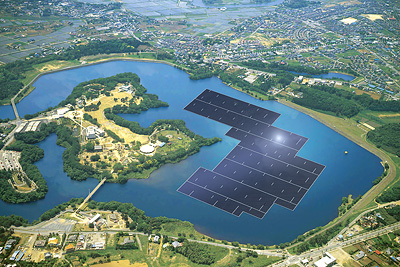
Image: Kyocera
A joint venture between two Japanese companies has embarked on building the world’s largest floating solar project.
The project is estimated to harvest 16,170 megawatt hours per year – enough to power around 4,970 households.
Not only will the floating solar farm – which will consist of 50,904 panels – produce a large amount of renewable energy, it will also play a major role in offsetting over 8,000 tons of carbon dioxide emissions annually (the equivalent of 19,000 barrels of oil).
Japan is making the move to “floatovoltaics” due to the lack of open land suitable for solar farms, but plentiful water surfaces. Proponents believe floating solar farms will be cheaper to produce than their land counterparts due to less strict regulations held on water surfaces.

